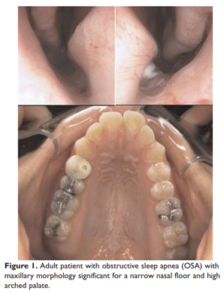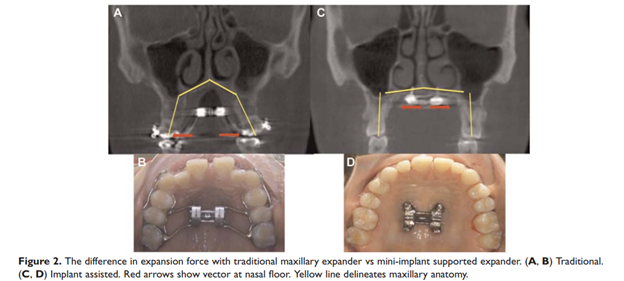- About Us
- Patient Resources
- EXPERTISE
ORTHODONTICS AND DENTOFACIAL ORTHOPEDICS
- TECHNOLOGY
- Blog
- Contact
DOME Treatment for Adult Obstructive Sleep Apnea Patients with High Arched Palate
According to recent research published in 2017 by the American Academy of Otolaryngology – Head and Neck Surgery Foundation, adults with OSA (obstructive sleep apnea) who have high arched palates, and little or no tolerance for CPAP treatment, have a very promising new treatment option: distraction osteogenesis maxillary expansion, or DOME.
Similar procedures have been very successful in treating pediatric patients with OSA and high arched palates both here in the US and abroad, but until recently had not been attempted in adult patients.
A joint study conducted at Stanford University (by the Division of Sleep Surgery, Department of Otolaryngology – Head & Neck Surgery, Stanford University School of Medicine; the Stanford University Sleep Medicine Division; the Department of Otolaryngology – Head & Neck Surgery, Cathay General Hospital, Taipei, Taiwan; the School of Medicine, Fu Jen Catholic University, Taipei, Taiwan and the Section of Pediatric Dentistry, Division of Growth and Development, UCLA School of Dentistry) selected 20 adult patients averaging 31.7 years old who had obstructive sleep apnea and high arched palates.
The patients were selected largely on their low or no tolerance for continuous positive airway pressure (CPAP) treatment or traditional oral appliance treatment, and their nasal floor width measurements that will be discussed more in-depth shortly.

*Figure 1 is a view of the typical candidate for DOME treatment.
This patient has the
narrow, high-arched palate that is often indicated in many OSA patients.
(Yes, that upper photo is a view up this person’s nose. Sorry. Medicine is often not very pretty or polite!)
The DOME treatment is a 4-part procedure:
The first step is usually done by your orthodontist in their office under local anesthesia. In this part, a custom-made maxillary expander and four to six mini-implants are installed in the roof of your mouth.
DOME treatment side effects?
It is normal and expected for you to experience tingling or prickling sensations in the roof of your mouth during the early weeks of treatment. It is caused by the stretching of the nerves in the roof of your mouth and does go away as new tissue grows and eases the tension on the cells.
Three people in the study experienced a small amount of bleeding inside their palates that slightly darkened their front teeth temporarily as they healed from the surgical portion of the procedure.
Overall, no cases of nasal infection, fistulas or malunion (of the bone ‘suture’) occurred in these 20 study patients. No one lost any of their teeth. (As horrific as that sounds, it has happened in some studies.)
How does DOME differ from traditional maxillary expanders?
Due to their active growing, children with OSA usually respond to traditional maxillary expanders quite well. However, for most adults, this treatment only pushes their molars outward, and doesn’t actually widen their palate/nasal floor, as seen below.

You can see in *Figure 2 above that the implant assisted (DOME) treatment is MUCH more effective for adult patients than traditional maxillary expanders.
What improvements can you expect to see with DOME?
The set of indices used in the Stanford study to compare before and after DOME treatment used the demographic, subjective and objective parameters of Body Mass Index, Epworth Sleepiness Scale, Nose Obstruction Symptom Evaluation, Apnea-Hypopnea Index, Oxygen Desaturation Index, Effective Resistance Inspiration of each lung, and Nasal Floor Width both at the front of the mouth and at the back.
The study measurements before and after DOME:
Characteristic Before DOME After DOME Difference
BMI 26.8 26.4 – 0.4
ESS 12.3 7.8 – 4.5
NOSE 11.7 3.85 – 7.85
AHI 30.9 14.2 – 16.7
ODI 23 8.7 – 14.3
Reff Insp left 1.4 1.0 – 0.4
Reff Insp right 1.4 0.9 – 0.5
NFW front – mm 22.7 27.4 + 4.7
NFW rear – mm 27.9 32.1 + 4.2
These numbers indicate averages for the entire group, but as you can see there were some significant changes in the NOSE, AHI and ODI numbers.
Easier breathing (NOSE, AHI, Reff Insp), improved oxygen saturation (ODI) and improved sleep quality (ESS, AHI) – and, no doubt, an improved smile, too! – plus super low risks and side effects – makes DOME a very attractive treatment option for adults with OSA and high arched palates.
To find out if you or someone you know might benefit from distraction osteogenesis maxillary expansion treatment, contact us here at Sunrise Orthodontics, or share this article with your orthodontist.
Sources:
Distraction Osteogenesis Maxillary Expansion (DOME) for Adult Obstructive Sleep Apnea Patients with High Arched Palate by Stanley Yung-Chuan Liu, MD, DDS; Christian Guilleminault, MD, DBiol; Leh-Kiong Huon, MD; and Audrey Yoon, DDS.
*Figures 1 and 2 sourced from the study PDF cited above, courtesy and property of Stanford University.
Admit it. You think all orthodontic offices are the same. Most are. We aren’t. We believe your experience should be something special.
Contact Us Today